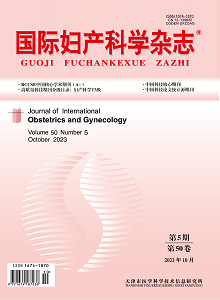Objective: To investigate the predictive value of joint use of fetal head circumference, fetal abdominal circumference and angle of progression (AOP) for the difficulty of operative vaginal delivery (forceps and vaccum). Methods: This prospective observational study was carried out in Department of Obstetrics of the People′s Hospital of Guangxi Zhuang Autonomous Region from May 2017 to July 2022. A total of 64 nulliparous women with singleton term pregnancies who required instrumentation to expedite vaginal delivery during the second stage of labor were included. Clinical data of pregnant women were collected after admission to the hospital. Fetal head circumference and fetal abdominal circumference were measured. Before performing operative vaginal delivery, AOP at rest and that during uterine contraction were measured by transperineal ultrasound (AOP1: mean of AOPs at rest, AOP2: mean of AOPs during uterine contraction). According to the outcomes of operative vaginal delivery, a case was included into "difficult or failed group" (Group A) when one or more of the following situations occurred: three or more tractions needed; successful operative vaginal delivery requiring sequential instruments (change vacuum to forceps); failed operative vaginal delivery; cesarean delivery due to a subjective impression of a difficult or failed traction; birth injury and the third- or the fourth-degree perineal tear. The rest cases were included into "successful and easy group" (Group B). Fetal head circumference, fetal abdominal circumference, AOP1 and AOP2 were used to establish four different predictive models by employing multivariable logistic regression. Receiver operator characteristic (ROC) curve was used to evaluate the discrimination of four models and the model with the largest area under ROC curve (AUC) was considered as the best one. Hosmer-Lemeshow test assessed the calibration of the optimal model. The optimal one was internally validated by using Bootstrap replicated sampling (1 000 times) method. Results: Statistically significant differences were revealed with regard to fetal head station by vaginal digital examination, duration of the last traction, initial direction of pulling in the last traction, fetal abdominal circumference, AOP1, AOP2, umbilical cord artery pH and rate of neonatal asphyxia (all P<0.05). A predictive model basing on the combination of fetal head circumference, fetal abdominal circumference, AOP1 and AOP2 showed the largest AUC (AUC=0.917, 95%CI: 0.821-0.972, Z=11.676, P<0.001). The Hosmer-Lemeshow test showed that χ2=5.873, P=0.661. Both of discrimination and calibration were good. The model showed good consistency in the internal validation. Conclusions: The simple model based on the combination of fetal head circumference, fetal abdominal circumference, AOP1 and AOP2 showed a predictive value for the difficulty of operative vaginal delivery and provided some basis for clinical decision-making.

